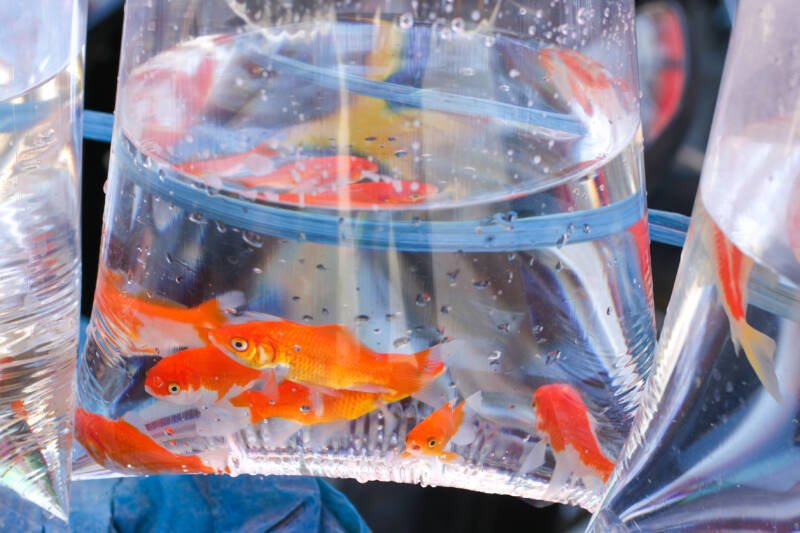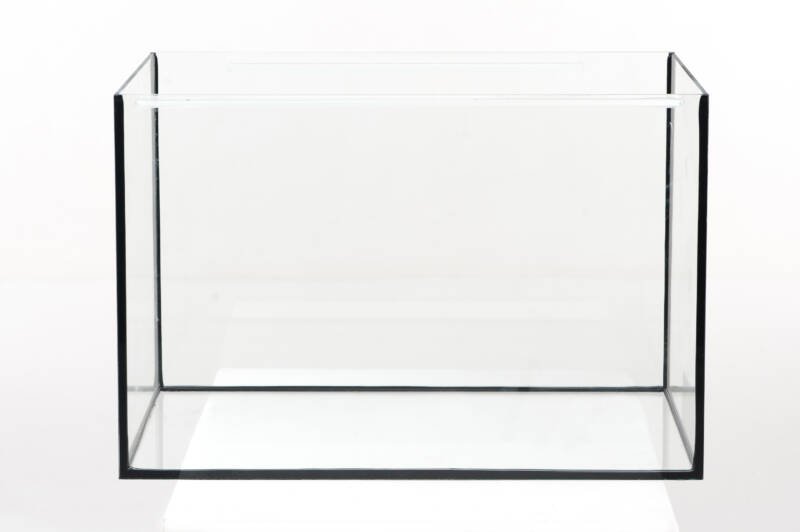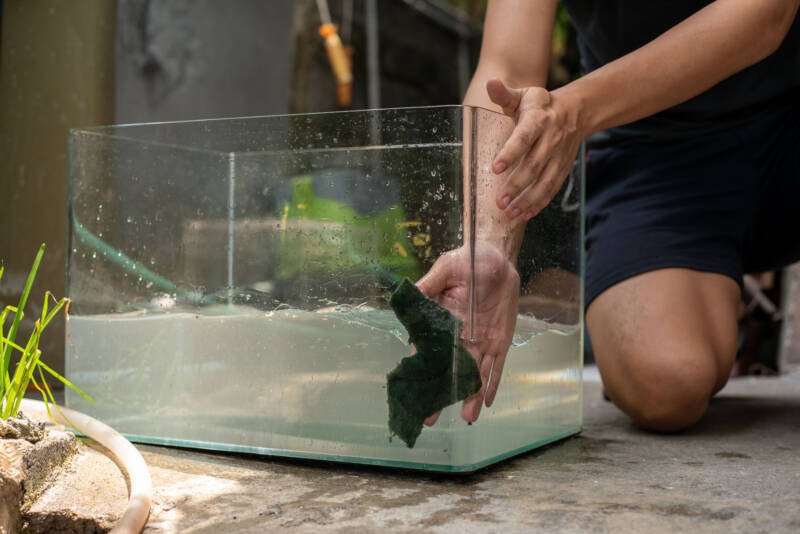The idea behind quarantine is to isolate new fish in a separate tank instead of adding them directly to your show aquarium.
Adding fish directly to your tank is an easy way to spread diseases, like ich, to the rest of your fish.
Quarantining gives you a chance to observe the fish for disease and treat them if necessary.

If you need to medicate the fish, you’ll only treat the small quarantine tank, not your entire show aquarium.
Some treatments will stain ornaments and silicone seams that hold the aquarium together.
A quarantine tank protects your main aquarium from staining.
In this article
What is a Quarantine Tank?

Unlike a show aquarium, a quarantine tank has no decorations. It is not designed to look beautiful.
The sole purpose is to house the fish in a comfortable setting, not provide a perfect home.
The quarantine aquarium is typically 5 to 10-gallons (19-38 l) but can be larger if you are keeping big fish.
What size aquarium?

Most aquarists can use a 5-gallon/19 l aquarium. This makes it easy to set up, heat, and maintain water quality.
Large fish require a larger aquarium, so they don’t feel stressed.
A quarantine tank can be any size but is normally smaller than the main aquarium because it is easier to take care of and it is easier to observe the fish.
Can I use a 5-gallon bucket?
No. It is impossible to view the fish’s sides and bottom when keeping them in a bucket. Therefore, you won’t be able to check the condition of the eyes, fins, skin, and belly.
Do I need a filter?
A quarantine tank is typically no larger than 10 gallons/38 l.
A hang-on-back filter will provide plenty of water movement and aeration in most cases.
You won’t be using activated carbon because it will remove the medication. Instead, you can empty the filter cartridge of carbon and use it as a mechanical filter.
Using an air stone instead of a filter
Many aquarists use an air pump and air stone to circulate the water and provide aeration.
It’s easy to regulate the amount of water movement with an airline valve.
Another option is a small power filter. However, if the power filter is too large, it can create too much flow and stress the fish.
You can use an air stone and a power filter. Fish with disease problems on their gills benefit from aerated water because they struggle to shed the parasites from their gills and breathe easier.
Biological filtration
The bacteria that convert ammonia to nitrite and then to nitrate will naturally colonize the tank. But the process takes about four weeks.
Some antibiotic medications can inhibit the formation of the biofilter.
Some aquarists add a sponge filter from another aquarium or use an old filter cartridge to seed the tank with beneficial bacteria. This can help reduce ammonia build-up.
Others make water changes when they detect ammonia in the water.
No matter what method you use, be sure to test the water for ammonia and make water changes if necessary.
Lighting
It’s best to keep the quarantine tank dimly lit. It calms the fish and helps them feel safer in the aquarium.
Ambient room lighting is all you need. If you need better lighting to check the fish for disease symptoms, slowly move the light over the tank to avoid starting the fish.
Do I need a heater?
Tropical fish require warm water. Room temperature is often too cool for the fish. Use a heater to maintain a stable temperature between 75-78°F (24-25.5°C).
Should I add gravel?
Aquarium gravel has no benefit in a quarantine tank. Gravel makes it harder to siphon debris from the bottom of the aquarium.
Feeding Fish in Quarantine
Even healthy fish may not eat right away after being placed in a quarantine aquarium.
Sick fish rarely eat until their health improves.
If you offer food and it is not eaten, remove it within a few minutes. Uneaten food decays and produces ammonia in the water.
If the fish likes and food and eats, keep checking the water for ammonia.
Water Changes
Healthy and sick fish continually shed their slime coat. This helps rid the surface of the fish of parasites and other pathogens.
Water changes remove the disease from the aquarium and help prevent reinfection.
Water changes also remove organics, ammonia, and nitrite. Therefore, even if you use a power filter, weekly water changes are recommended.
Siphon out solid waste, food particles, and other debris.
Using water with the same temperature, change 25 to 50% of the water once a week.
How Long to Quarantine?
Aquarists are often impatient when it comes to quarantining new fish. After a few days, they’re eager to add the fish to their show tank.
Unfortunately, disease symptoms can take up to 10 days to appear.
The ideal quarantine period is four weeks. This allows you plenty of time to observe the fish and watch for signs of disease like heavy breathing, clamped fins, fungus, and other disease symptoms.
Can I quarantine marine fish?
Yes. You will need to mix up saltwater and have it on hand for making water changes.
Quarantining Corals
Some coral suppliers quarantine their corals to ensure they are free of parasites and other health issues.
Reef aquarists often simply add new frags to their tanks. Others choose to isolate the new specimens in a small isolation tank.
The idea is to watch for signs of tissue decay or parasites crawling on the colony.
You can feed the frags coral food but test the water frequently and make small water changes every few days.
Can I quarantine shrimp and snails?
Yes. While there are no medications for shrimp and snails, an isolation period will make sure your new specimens are healthy and won’t spread disease to your show aquarium.
Medicating and the Quarantine Aquarium
Diagnosing diseases is difficult because we often only see symptoms, not the disease organism.
Therefore, aquarists can only make an educated guess as to the cause of the illness, then select a medication claiming to treat the symptoms.
No matter what medication you choose, follow the directions on the package.
Do not overdose, as it will not improve the fish’s recovery. Under-dosing is not recommended because the diluted medication is likely to be ineffective.
If you have any questions or comments, please leave them below.